Exploring Grown Brilliance in Gemstones
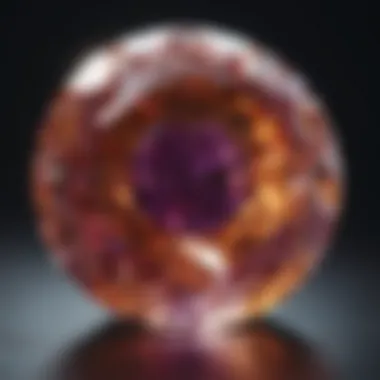
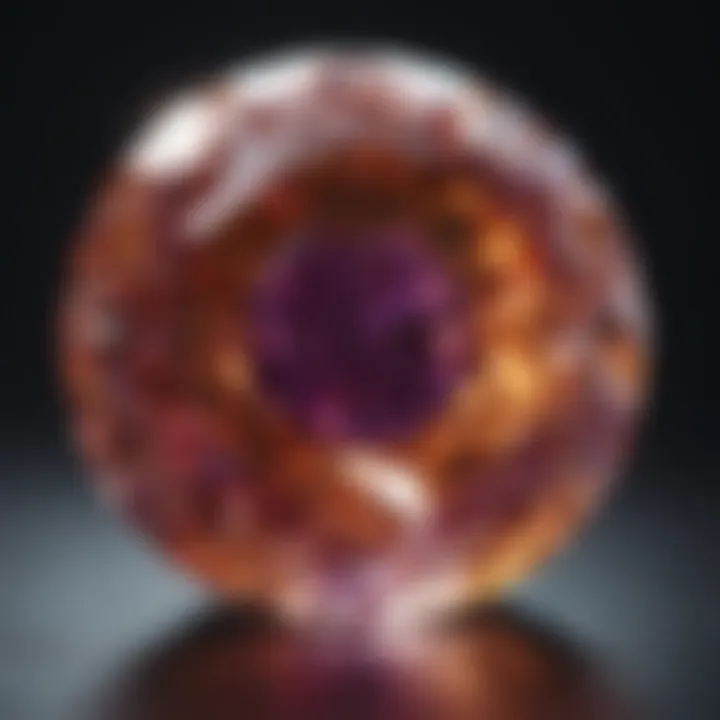
Intro
The world of gemstones is a shimmering realm where nature's artistry meets human ingenuity. As we dive into the intricacies of grown brilliance, it’s essential to grasp the foundational aspects of these treasured stones. What exactly defines a gemstone, and how do their classifications set the stage for understanding their brilliance? This article aims to illuminate the multifaceted concept of grown brilliance, illustrating the process from natural formation to human enhancement, while examining its implications in the ever-evolving landscape of gemstones.
Gemstone Overview
Definition of Gemstones
Gemstones are, at their core, naturally occurring substances prized for their beauty, durability, and rarity. They come in various forms, including minerals like diamond and sapphire, as well as organic materials like pearl and amber. Typically, a gemstone is recognized not only for its exquisite appearance but also for its metaphysical properties and symbolic value associated with different cultures. Their allure has fascinated humanity for ages, making them more than mere decorative trinkets; they are often seen as carriers of deeper significance.
Classification of Gemstones
Understanding how gemstones are classified provides a clearer perspective on their brilliance. They can generally be categorized into two main types: precious and semi-precious stones. Precious stones include diamonds, rubies, sapphires, and emeralds, valued for their exceptional rarity and quality. Semi-precious stones, while still captivating, are often more abundant and include varieties such as amethyst, garnet, and turquoise.
Additionally, gemstones can be classified based on their chemical composition and crystallography, with subcategories like:
- Minerals: Characterized by their crystalline structures, e.g., quartz and topaz.
- Organic Gemstones: Formed from biological processes, like coral and pearl.
- Synthetic Gemstones: Created in lab environments, intended to mimic natural stones.
Impact of Natural Environments on Characteristics
The natural environments play a crucial role in shaping a gemstone's characteristics. Factors such as temperature, pressure, and mineral content contribute significantly to the stone's final attributes, including color, clarity, and hardness. For example, the rich blue hues of a sapphire often result from the presence of iron and titanium during its formation process. This interplay between nature’s variables and a gemstone’s intrinsic properties leads to a vast array of characteristics among stones, influencing their visual appeal and market value.
"The qualities of gemstones, from their luster to their hardness, are often reflections of the environments in which they form."
As we further explore the theme of grown brilliance, it is essential to understand how human intervention enhances these natural gifts, setting the stage for the subsequent discussions on both the metaphysical significance and practical applications in jewelry crafting.
Historical Significance
Origins of Gemstone Use
From the dawn of civilization, gemstones have been intertwined with culture, spirituality, and status. The earliest use of gemstones can be traced back to ancient Egypt, where stones such as lapis lazuli and carnelian were adorned in royal jewelry and used in amulets believed to hold protective properties. Their use by ancient rulers to showcase wealth and power laid the groundwork for the roles gemstones play in society today.
Cultural Insights: Gemstones in Ancient Civilizations
Throughout history, different civilizations attributed distinct meanings and powers to various gemstones. In ancient Greece, for instance, amethyst was thought to ward off drunkenness, while in the Middle Ages, it was revered for its association with the spiritual realm.
In India, gemstones were tied to astrology, with each stone linked to a particular planet, believed to enhance a person's fortune and auspiciousness. This cultural significance has carried through the ages, contributing to the rich tapestry of beliefs surrounding gemstones.
As we continue through this journey into the concept of grown brilliance, these cultural references and historical uses underscore how deeply embedded gemstones are in human experience and ethics, further enriching the discussion of their relevance today.
Foreword to Grown Brilliance
The realm of gemstones captivates many, offering a blend of aesthetics, cultural significance, and scientific intrigue. Among the myriad qualities that gemstones possess, the concept of ‘grown brilliance’ stands out as a particularly compelling subject worthy of exploration. This concept is not just about the shine or visual appeal of gems; it encapsulates a variety of factors, including formation processes, human intervention, and the emotional connections that these stones forge with individuals.
Understanding grown brilliance allows us to appreciate the depth and complexity of gemstones far beyond their surface beauty. As gemstone enthusiasts, collectors, and jewelry designers dive into this world, recognizing the nuances shared between natural and human-enhanced stones is key. These insights are pivotal for making informed decisions, whether one is selecting a piece for personal enjoyment or investment. This discussion will unpack the definition of grown brilliance, delve into its historical context, and examine various aspects of gemstone formation and enhancement.
Defining Grown Brilliance
Grown brilliance refers to the radiance and luster that gemstones acquire either through natural formation or enhanced through human techniques. It’s not merely about how gemstones glimmer under the light, but rather about the conditions and processes that lead to their stunning appearance.
In natural gems, this brilliance occurs through geological processes that take millions of years, involving extreme heat and pressure. In contrast, grown brilliance also encompasses those gemstones that are synthesized or treated to elevate their aesthetic qualities. For instance, synthetic diamonds reach their brilliance through controlled settings that mimic natural growth conditions but with increased speed and predictability. This definition reflects both the scientific and artistic principles behind gemology, highlighting how beauty can emerge from various methods.
Historical Context
To fully grasp the concept of grown brilliance, it helps to look back at the historical development of gemstones. In ancient civilizations, gemstones were often believed to hold mystical properties and were used as talismans. The knowledge of how to cut, polish, and treat gems has evolved through centuries. The earliest techniques were rudimentary, often resulting in gemstones that couldn’t shine to their full potential.
With the advent of the Industrial Revolution, new tools and techniques emerged, allowing gem cutters to enhance brilliance through precise geometry and surface finishing. From the introduction of faceting to heat treatments used to intensify color, these advancements led to the gems we recognize today. Over time, the perception shifted; consumers began to appreciate both naturally occurring and human-enhanced gems not just for their rarity, but also for the stories they tell through their creation.
"Grown brilliance represents not just the culmination of mineralogy and craftsmanship; it is a celebration of both nature's artwork and human ingenuity."
To this day, the dialogue around gemstones continues to evolve. As we reflect on their historical significance, it’s clear that our understanding of brilliance has been continually shaped by cultural, scientific, and artistic expressions.
Formation of Gemstones
The formation of gemstones represents a foundational element in understanding what contributes to their beauty and value. It is within this section that we will delve deeper into the natural processes and influential environmental factors that shape these remarkable treasures of the Earth. Understanding gemstone formation is pivotal, as it directly affects the characteristics and appeal that both natural and grown gemstones possess.
Natural Processes of Gem Formation
Gemstones originate through various natural processes, often taking millions of years to develop into the glistening forms we admire today. One cornerstone of gemstone formation is mineral crystallization. This occurs deep within the Earth’s crust, where extreme heat and pressure can lead minerals to bond in an ordered structure, resulting in crystals. For instance, diamonds, being one of the hardest materials known, are a product of carbon atoms being subjected to intense heat and pressure deep underground, where they arrange themselves into an intricate lattice.
Another important method is the process of sedimentation. Gemstones like opals form from the gradual accumulation of silica over time. As water with dissolved minerals infiltrates rock fractures, the silica precipitates, ultimately leading to the formation of lovely opal gems. Each of these natural processes imparts different physical properties and aesthetic qualities to the gemstones, creating a variety of colors, patterns, and optical phenomena.
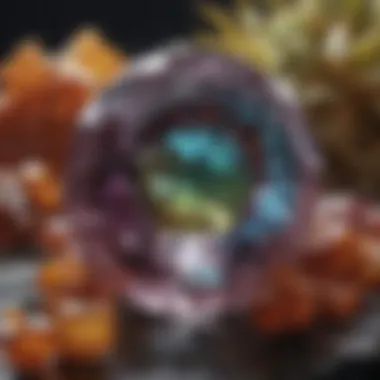
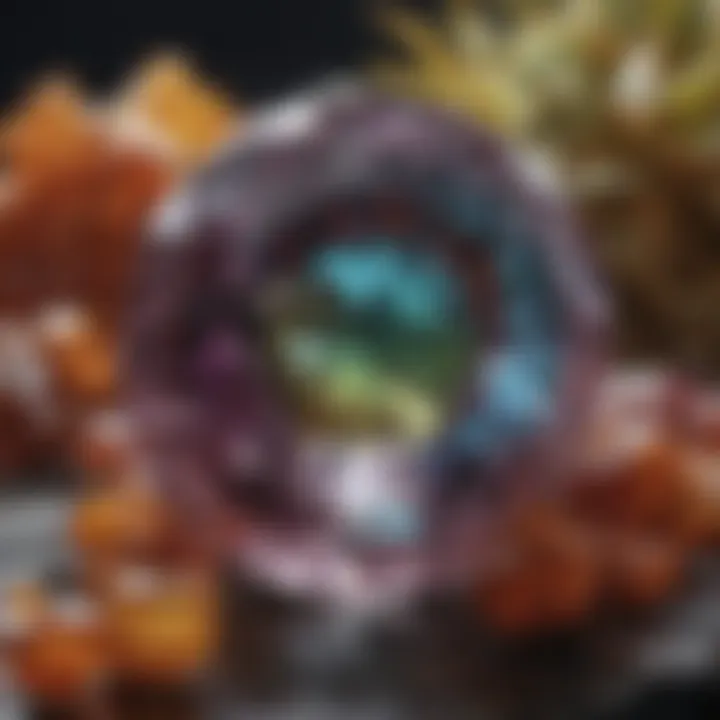
"The intricate interplay between time, pressure, and elemental composition is what makes each gemstone unique in its brilliance and allure."
Additionally, volcanic activity plays a significant role. For example, gemstones such as peridot and garnet can form in the lava flows. As magma cools, specific minerals crystallize, resulting in colorful and dazzling gems. The understanding of these processes not only enriches our appreciation for these stones but also helps inform their market value, as rarer formation processes often yield more valuable gemstones.
Role of Environmental Factors
While natural processes are crucial in the formation of gemstones, environmental factors also significantly impact their development and eventual characteristics. For instance, the geological environment—such as the type of rock, temperature variations, and presence of other elements—can greatly influence the color and clarity of the stones.
Temperature fluctuations can affect how minerals crystallize. Some minerals require specific temperature ranges to form optimally. For example, under cooler conditions, a mineral like amethyst may develop an intense purple hue, whereas in warmer conditions, the same mineral can appear more subdued. Thus, two crystals of amethyst from different geological settings might display marked differences.
Similarly, impurities present during formation can lead to distinctive traits. The presence of trace elements can alter a gemstone’s color. Take emeralds, for example—these stones derive their lush green color from trace amounts of chromium and vanadium. In the absence of these elements, the stone might take on a vastly different hue. Therefore, studying the environmental factors allows us to appreciate not merely the aesthetics but also the geological context of these stunning gems.
In summary, the formation of gemstones is a complex interplay between time, nature, and environment. Understanding these elements gives gemstone enthusiasts and collectors profound insight into both the allure and investment potential of these natural wonders.
Enhancement Techniques
Enhancing the natural beauty of gemstones plays a crucial role in the jewelry industry. This process is more than just superficial polishing; it taps into the very essence of what creates a stone's allure. Enhancement techniques serve to elevate the inherent characteristics of gemstones, allowing them to shine even brighter in the marketplace and among collectors. Understanding these techniques offers valuable insight into both the craftsmanship behind jewelry production and the factors that influence gem value.
Cutting and Polishing
Cutting and polishing are vital steps in the enhancement of gemstones, affecting both their aesthetic appeal and overall value. When we think about gems, the first image that comes to mind is usually their sparkling facets, which catch the light beautifully. A well-cut stone not only enhances brilliance but also amplifies a gem's natural color, making it more alluring.
The most skilled lapidaries—those who cut and polish gems—know that different shapes and cuts will affect how light interacts with the stone. For instance:
- Brilliant cut: This popular cut maximizes light return, resulting in a dazzling effect.
- Emerald cut: This cut emphasizes clarity and color rather than brilliance, lending an air of elegance.
Several factors come into play during the cutting process, including:
- The quality of the rough material, which determines what shapes are possible.
- The concept of yield, or how much of the rough stone can be used without wasting valuable material.
- The desired end product, as different designs can dramatically impact the perception of the stone.
Therefore, cutting is not just a mechanical process; it's an art that requires deep knowledge and experience.
Heat Treatment and Radiation
Another significant method of enhancement comes from heat treatment and radiation, techniques that can alter a gemstone's color and clarity. These methods aren't just modern conveniences; they are practices that have been around for centuries. The most renowned gems such as rubies and sapphires often undergo these treatments.
- Heat treatment: This process involves heating the gemstones at high temperatures to improve their color. For instance, blue sapphires seen commonly in jewelry are often heat-treated to intensify their color.
- Radiation: This technique can either enhance or change the color of certain stones. For example, some diamonds undergo irradiation to bring out vivid hues, turning yellow diamonds into striking blue ones.
Despite their advantages, these methods can raise questions about the authenticity and natural state of the stones. Consumers are increasingly curious about the origins of their gems, which have led to a more informed market. Labels and certifications are becoming essential, as buyers seek transparency in where and how stones have been treated.
"Ultimately, the techniques used—be they cutting, polishing, heat treatment, or radiation—emphasize the relationship between nature’s raw beauty and the artisan’s touch."
Enhancement techniques, therefore, are not merely applications to improve the visual characteristics of gemstones; they play a pivotal role in defining the market dynamics and consumer perceptions. As the industry evolves, keeping pace with advancements in enhancement methods is essential for those engaged in the world of gemstones.
The Metaphysical Properties of Brilliance
The exploration of metaphysical properties within the realm of gemstones is as intricate as the stones themselves. The notion of brilliance transcends mere aesthetic appeal; it delves into the energies and meanings attributed to these remarkable creations of nature. This section addresses how the allure of gemstones often intertwines with belief systems and cultural practices, enriching their significance beyond what the eyes can perceive.
The Alleged Energetics of Gemstones
Throughout history, various cultures have attached distinct energetic qualities to gemstones, suggesting that these stones possess unique vibrations or frequencies that can influence human experience. For instance, many people believe that amethyst fosters calm and clarity, while citrine is said to attract wealth and abundance. Each gemstone is viewed as a carrier of specific properties that may correspond to emotional needs or spiritual aspirations.
- Common Beliefs:
- Rose Quartz: Often labeled as the stone of love, it is thought to enhance feelings of compassion and emotional healing.
- Sapphire: Associated with wisdom and nobility, sapphires are believed to inspire authenticity and spiritual insight.
These energetics play a crucial role in informal settings where gems are used in meditation, healing practices, and personal growth, where individuals engage with the vibrations of these stones in search of transformation.
"Stones are not just pretty, they are thought to hold the keys to unlock various dimensions of our being."
Notably, some skeptics question these claims, suggesting that the physiological and psychological effects experienced by individuals could stem from the power of suggestion rather than any intrinsic energy of the stones themselves. Nevertheless, the continued interest in gemstone energetics illustrates a deep-seated desire to connect with something greater than oneself, making this aspect of gemstones profoundly meaningful for many.
Cultural Significance Across Civilizations
The historical significance of gemstones is rich and varied, deeply embedded in the fabric of many civilizations from ancient Egypt to contemporary cultures worldwide.
In ancient times, gemstones were not merely ornamental; they carried substantial weight in rituals, legendary tales, and societal statuses:
- Egyptians: They adorned sarcophagi with lapis lazuli, believed to protect and guide the soul in the afterlife.
- Greeks and Romans: Both civilizations saw gems as symbols of power and prestige, often used in royal regalia and sacred artifacts.
As societies evolved, the intricacies surrounding gemstones grew; they became prized possessions within different cultural contexts, each attributing diverse meanings to the gemstones depending on their origins or the properties associated with them. Many indigenous tribes see gems as part of their connection to the earth, believing they hold ancestral wisdom.
Today, gemstone jewelry often incorporates not only individual tastes but also spiritual beliefs, reflected in the aesthetic choices consumers make. The choice of a particular gemstone may resonate with historical symbolism, rejecting the idea of mere fashion for a more profound affiliation with their past.


This intermingling of culture and gemstones highlights that what one wears is often much more than a visual accessory; it embodies a story, a belief, and a connection to both heritage and modern identity. In the end, the metaphysical properties of brilliance tell a compelling tale, one that refuses to fade in the face of contemporary challenges.
Grown Versus Natural Gemstones
The distinction between grown and natural gemstones is crucial for understanding their value and appeal. Both categories play a significant role in the market and offer unique benefits. Grown gemstones present an option that balances affordability, ethical sourcing, and innovation, while natural gemstones carry a deep-rooted historical significance that makes them desirable to many collectors and enthusiasts.
Understanding the Differences
When it comes down to it, what sets grown and natural gemstones apart? The differences are like day and night, even though both categories share the same enchanting features. Grown gemstones, often labeled as lab-created or synthetic, are made through processes mimicking nature in controlled environments. For instance, methods such as the Czochralski process, where single crystals are pulled from molten material, can produce gems with remarkable clarity and brilliance.
On the other hand, natural gemstones are formed over thousands to millions of years through geological processes involving heat, pressure, and time. Let's look at their key differences in detail:
- Origin: Natural gemstones come straight from the earth, while grown gemstones are engineered in labs.
- Cost: Grown gemstones often have a lower price tag. Many people find them more accessible.
- Inclusions and Flaws: Natural stones might contain inclusions, which can affect their quality. Grown gemstones typically exhibit fewer imperfections, making them visually striking.
- Sustainability: The ethical implications sway many consumers. Grown gemstones eliminate the environmental damage associated with mining.
In terms of durability, many grown stones consist of materials that are harder or purer, enhancing their ability to withstand wear and tear. Still, natural gemstones have their own endearing qualities that some simply can't resist.
Consumer Attitudes and Perspectives
Shifting to consumer attitudes, there’s often a palpable divide in opinions surrounding grown and natural gemstones. Many traditionalists argue that natural stones carry an authenticity that cannot be replicated when they come from a lab. This stems from the long history and personal stories attached to these natural portions of our planet.
Conversely, a newer wave of consumers—especially millennials and Gen Z—are enthusiastic about the innovation involved in creating grown gemstones. They appreciate the ethical sourcing and environmental stewardship these gems represent. In fact, some statistics indicate that over 60% of younger buyers prioritize sustainability when choosing gemstones.
"What's behind a gem’s story? It's about more than just how it sparkles. It's the journey it takes and the principles it represents."
Preferences can also vary significantly by region. For example, in urban areas where eco-conscious living trends are on the rise, grown gemstones may enjoy increased demand compared to traditional natural supplies.
Trends in Gemstone Jewelry
In the world of gemstone jewelry, trends evolve at a pace that can leave both enthusiasts and casual buyers scratching their heads. Understanding current trends is vital for anyone invested in the gemstone market—whether it's consumers looking for a timeless piece, designers seeking inspiration, or collectors wanting to splash their cash on the next big thing. This section will delve into the latest market trends and innovative designs that shape the landscape of gemstone jewelry today.
Current Market Trends
The growth of the gemstone market is somewhat like a fine wine – it only gets better with age. Recent years have seen a marked shift towards sustainability and ethical sourcing. Consumers are increasingly wary of where their gemstones come from, pushing designers to become more transparent in their supply chains. Here are a few key trends currently reshaping this market:
- Sustainable Sourcing: More brands are now utilizing ethically mined gemstones or lab-created alternatives like Moissanite or lab-grown diamonds, appealing to eco-conscious consumers.
- Customization: Personalization in jewelry design is on the rise. Buyers are hunting for unique, one-of-a-kind pieces that reflect their individual taste or life stories.
- Minimalism: The aesthetic of "less is more" holds sway over many buyers. Simple designs featuring single stones or subdued settings have become preferred.
- Color Trends: Bold colors are making a splash, with gemstones like turquoise, ruby, and amethyst gaining traction, often paired with unconventional materials to create striking contrasts.
These trends not only signal shifts in consumer values but also paves the way for future designs and opportunities within the market. As such, they reflect a broader narrative where gemstone jewelry is no longer just adorned on a piece; it symbolizes ideals and commitments.
Innovative Designs and Techniques
In today's world, innovative designs and new techniques are the heartbeat of the gemstone jewelry industry. With advancements in technology and creative pushes from designers, the possibilities are seemingly endless.
- 3D Printing: This technology is revolutionizing how jewelry is made. Designers can create complex shapes that would be too difficult or time-consuming to produce by traditional methods. As a result, intricate and elaborate designs are becoming more accessible.
- Mixed Media: The blending of various materials continues to dominate. From gemstones integrated with wood, glass, or even fabric, mixed media designs are not just trendy; they add depth and context to the jewelry pieces.
- Emotional Design: Designing jewelry that evokes emotions is becoming a craft in itself. Pieces are crafted to represent concepts like love or renewal, often drawing on gemstones’ historical meanings.
- Smart Jewelry: Wearable tech is influencing jewelry design, with some pieces offering more than just aesthetic appeal. From rings that track health metrics to bracelets that send notifications, the fusion of technology with traditional elements is gaining attention.
The innovation never sleeps for gemstone jewelry designers, and what may seem avant-garde today often becomes mainstream tomorrow.
Investment Potential of Gemstones
The investment potential of gemstones is an area of increasing interest in recent years. Whether you're a seasoned collector or just entering the world of fine gems, understanding the investment aspects of gemstones can be crucial. Investing in these natural treasures offers a range of benefits, not just financial ones but also aesthetic and cultural appreciations. As gem enthusiasts seek long-term ways to diversify their portfolios, grasping the unique dynamics behind gemstone values becomes essential.
Evaluating Gemstone Value
When evaluating the value of gemstones, several factors come into play. These include:
- Rarity: The scarcity of a gemstone directly influences its market value. Stones like diamonds and rubies are coveted due to their limited availability.
- Quality: Characteristics such as color, clarity, cut, and carat weight play significant roles. A well-cut stone with vivid color will fetch a higher price.
- Provenance: The origin and history of a gemstone can affect its desirability. Stones with known and reputable backgrounds often carry a premium.
- Market Demand: Trends in jewelry and fashion, as well as shifts in consumer preferences, can fluctuate the value of particular gemstones. For instance, the rise in popularity of sapphires and emeralds has led to increased investment.
Understanding these factors can provide collectors and investors alike with a more nuanced appreciation of what a gemstone is worth.
"Investing in gemstones is not merely purchasing a beautiful object, it's about understanding the story behind that object, the craftsmanship, and its journey to you."
Long-term Investment Perspectives
Looking at gemstones as a long-term investment can yield interesting insights. Several key considerations shape the long-term outlook for gemstone investments:
- Market Resilience: Historically, gemstones have demonstrated resilience during economic downturns. Unlike stocks or bonds, which can fluctuate wildly with market conditions, gemstones often maintain their value.
- Increasing Interest: As global awareness and appreciation for ethical and sustainable sourcing grow, the demand for ethically sourced gemstones has surged. This trend suggests a promising future market, as buyers increasingly value integrity in their purchases.
- Cultural Resource: Investing in gemstones is also about acquiring pieces of cultural heritage. As countries and cultures promote their native gems, investment in local stones may prove lucrative and meaningful.
- Diversification: For investors, gemstones provide a means of diversifying one's portfolio. Unlike standard assets, gemstones can offer emotional and aesthetic satisfaction alongside financial value.
In summary, while there are no guarantees in investing, the timeless allure and distinct characteristics of gemstones can make them an enticing option for those looking to secure and grow their wealth over time.
Care and Maintenance of Gemstones
Caring for gemstones isn't just about aesthetics; it's about preserving their inherent beauty and value over time. Much like any treasured possession, gemstones require thought and attention to maintain their stunning appearance and structural integrity. Understanding the significance of proper care can elevate your appreciation of these captivating stones, not just as jewelry pieces but as lasting investments.
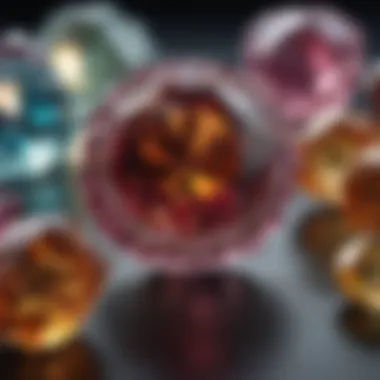

Best Practices for Care
To ensure your gemstones remain as brilliant as the day you acquired them, it’s crucial to follow some best practices:
- Regular Cleaning: Dust, oils, and dirt accumulate over time. A gentle clean with warm, soapy water and a soft cloth or brush can work wonders.
- Safe Storage: Always store your gemstones away from other jewelry to avoid scratches. Use a soft pouch or a lined box to keep them safe.
- Avoid Harsh Chemicals: Perfumes, lotions, and cleaning agents can dull the shine of your gemstones. It's best to apply these substances before putting on your jewelry.
- Limit Exposure: Some stones, like opal or turquoise, are more delicate. Limit their exposure to extreme temperatures and harsh environments.
- Periodic Professional Care: Just like any valuable asset, regular checks by a professional jeweler can spot potential issues before they turn into costly repairs.
Preserving Brilliance Over Time
The brilliance of gemstones is often what draws enthusiasts and collectors alike. To maintain their sparkle:
- Keep Away from Direct Sunlight: Extended exposure can fade certain stones. Store them in a cool, dark place when not in use.
- Polish with Caution: Over-polishing can strip the surface. Use polishing cloths designed for specific types of gems—avoid using them on every stone you own.
- Be Mindful of Wear: Being too vigorous with wear can result in chipping or scratching. Some gemstones, like softer garnets or pearls, require extra caution.
- Utilize Technology: Nowadays, there are ultrasonic cleaners available that gently clean without causing harm, but make sure your stones are suitable for this method before diving in.
"A gem is not just a piece of earth's treasure; it's a culmination of time, artistry, and care. Preserve it right, and it becomes not just a possession, but a legacy."
Taking the time to understand and implement these care strategies can ensure your gemstones remain visually captivating and maintain their worth in the long haul. It's about nurturing a relationship between you and these natural wonders.
Sustainability in Gemstone Sourcing
The notion of sustainability in gemstone sourcing has emerged as a pressing issue within the jewelry and gemstone industries. Grown brilliance is not solely about how a gemstone looks; it encompasses how and where it comes from. Ethical sourcing plays a pivotal role in maintaining both environmental integrity and social responsibility. With the heightening awareness of ecological footprints and human rights issues, consumers are more inclined to choose gemstones that are sourced sustainably. That means there’s an increasing demand for transparency in both mining practices and the origins of the gemstones themselves.
Ethical Considerations
Ethically sourced gemstones are those obtained in a manner that respects human rights and the environment. When making a purchase, consumers often seek information about several key ethical factors:
- Fair Labor Practices: Are workers involved in the mining or production of these gems treated fairly? This includes safe working conditions, fair wages, and a lack of child labor.
- Community Impact: How does gem mining affect local communities? Sustaining local livelihoods is paramount; ethical sourcing aims to ensure that the benefits of gemstone extraction directly support these communities rather than exploit them.
- Conflict-Free Policies: The term "blood diamonds" lingers in the public consciousness. Ethical sourcing means guaranteeing that gemstones do not finance violence or oppression, especially in conflict zones.
This consideration of ethics is not merely a selling point; it translates to real-world impacts. Companies that embrace ethical sourcing become leaders of a movement that values people and planet over profits.
Environmentally Friendly Practices
The environmental ramifications of gemstone extraction are significant, often leading to habitat destruction, pollution, and water depletion. Adopting environmentally friendly practices can mitigate these impacts, such as:
- Responsible Mining Techniques: Using methods that minimize harm to ecosystems. Techniques like selective mining preserve the surrounding environment, reducing the footprint left behind.
- Recycling and Upcycling: Encouraging processes that not only utilize existing materials but also reduce the need for new mining operations. This can include repurposing old jewelry into new designs, allowing pre-existing gems to shine once again.
- Tracking and Certification: Using blockchain technology and certification from reputable organizations can ensure that gemstones are sourced responsibly. This kind of transparency helps consumers feel confident in their purchases.
In a world where environmental and ethical concerns are paramount, gemstone sourcing needs to evolve. Consumers are awakening to the impact their choices make, and businesses must adapt to this change.
As we navigate the future of gemstone sourcing, the integration of sustainability is critical. It shapes not just the aesthetics of gemstones but their entire narrative. Understanding these elements not only enriches appreciation for the stones themselves but also highlights the importance of protecting our planet and its resources.
The Future of Grown Brilliance
The topic of the future of grown brilliance in gemstones is something that wields significant importance, not just for jewelers and collectors, but also impacts environmental concerns and consumer choices. As we step into a world that increasingly values sustainability, the relevance of grown gemstones cannot be overstated. These stones, created under controlled conditions, offer a responsible alternative to mined stones. The advancement in technology and shifting consumer preferences is driving the market toward a future where creativity, ethics, and innovation coalesce.
Emerging Technologies in Gem Creation
Emerging technologies are reshaping the way gemstones are created and perceived. Machine learning, optical sciences, and new crystallization methods are paving the way for improved quality and color diversity in lab-grown stones. For instance, the use of laser processes allows for precision cutting that enhances the stone's inherent brilliance.
Furthermore, chemical vapor deposition (CVD) and high-pressure high-temperature (HPHT) methods have gained traction. These techniques enable the literal synthesis of gemstones such as diamonds and sapphires that rival their natural counterparts in clarity and size.
- CVD: This method involves gases that, under the right conditions, crystallize into diamond. It is considered a breakthrough as it allows the creation of large stones at a fraction of natural scarcity.
- HPHT: High heat and pressure replicate the natural formation processes of diamonds. This technique can yield stunning results in terms of not just visual appeal but also structural integrity.
With the ongoing research, we can expect even more innovative methods that could further bridge the gap between natural and grown gems. As these technologies continue to evolve, they will bring forth new possibilities for designers and consumers alike.
Consumer Trends and Market Adaptation
Looking at consumer trends, there's a marked shift toward ethically sourced and sustainable products. Today’s buyer is more informed than ever, seeking not just the beauty of gemstones, but also their backstories. This emphasis on sustainability is trickling down to all aspects of the gemstone industry.
- Ethical Considerations: As concerns rise over the unethical practices in mining, such as child labor and environmental destruction, consumers are leaning towards lab-grown options, which provide peace of mind.
- Customization and Personalization: Another trend is the desire for unique pieces. The ability to create stones with specific color attributes or clarity levels to match individual needs is driving market growth.
- Digital Experience: E-commerce platforms are also adapting, offering virtual try-ons and interactive product demonstrations to cater to a tech-savvy audience.
The market’s adaptation to these consumer demands indicates a robust and flexible future for grown brilliance in gemstones. With emerging technologies enhancing both production and consumer engagement, this segment is likely to flourish.
In the novice dialogue of gem enthusiasts, the credibility of grown brilliance is not just an aesthetic choice—it's progressively becoming a philosophical one as well.
Ending
The conclusion of this article emphasizes the significance of understanding grown brilliance in gemstones. This not only encompasses the aesthetic appeal that has captivated jewelry enthusiasts for centuries but also invites a discussion on the evolving techniques that enhance and preserve the beauty of these natural wonders. By diving into the nuances that define both natural and grown gemstones, we can illuminate how each contributes to the market, shaping not just consumer choices but also the future direction of the jewelry industry.
Summarizing Key Insights
Through the exploration of grown brilliance, we uncover several essential insights:
- Diverse Origins: Grown gemstones, synthesized in laboratories, mirror the brilliance of their natural counterparts while offering ethical alternatives to consumers wary of mining impacts.
- Enhancement Practices: Techniques such as cutting, polishing, and heat treatment play a vital role in maximizing a stone's clarity and shine, showcasing human artistry intertwined with nature's gifts.
- Cultural Significance: Gemstones have held symbolic meanings across various societies. The blend of natural and cultivated gems reflects both heritage and craftsmanship, catering to different consumer sentiments.
Understanding these aspects elevates appreciation for the craft behind gemstones, allowing enthusiasts to make more informed decisions.
The Ongoing Journey of Gem Appreciation
The journey of gem appreciation extends far beyond mere aesthetics. It's a continuous dialogue between culture, science, and art. As technology advances and consumer preferences shift, the world of gemstones faces both challenges and opportunities. New techniques in processing and understanding the deeper meanings associated with these stones amplify their allure. The ongoing commitment to ethical sourcing and sustainable practices will undoubtedly shape future generations' connections to these gems.
In closing, the exploration of grown brilliance encourages an appreciation that challenges typical perceptions. Recognizing both natural and synthesized gemstones in their own light can foster a greater respect for the craft and a deeper understanding of what these gems truly symbolize. Such insights may inform future collectors, designers, and enthusiasts, ensuring that the journey of gem appreciation continues, enriched by knowledge and passion.



